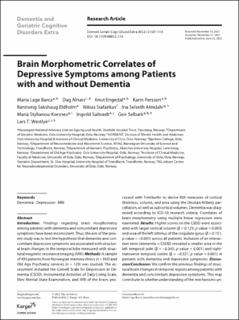| dc.contributor.author | Barca, Maria Lage | |
| dc.contributor.author | Alnæs, Dag | |
| dc.contributor.author | Engedal, Knut | |
| dc.contributor.author | Persson, Karin Ester Torun | |
| dc.contributor.author | Eldholm, Rannveig Sakshaug | |
| dc.contributor.author | Siafarikas, Nikias Ioannis | |
| dc.contributor.author | Almdahl, Ina Selseth | |
| dc.contributor.author | Korsnes, Maria Stylianou | |
| dc.contributor.author | Saltvedt, Ingvild | |
| dc.contributor.author | Selbæk, Geir | |
| dc.contributor.author | Westlye, Lars Tjelta | |
| dc.date.accessioned | 2022-11-28T13:54:09Z | |
| dc.date.available | 2022-11-28T13:54:09Z | |
| dc.date.created | 2022-06-29T08:56:47Z | |
| dc.date.issued | 2022 | |
| dc.identifier.citation | Dement Geriatr Cogn Disord Extra. 2022,12, 107–114. | en_US |
| dc.identifier.issn | 1664-5464 | |
| dc.identifier.uri | https://hdl.handle.net/11250/3034523 | |
| dc.description.abstract | Introduction: Findings regarding brain morphometry among patients with dementia and concomitant depressive symptoms have been inconsistent. Thus, the aim of the present study was to test the hypothesis that dementia and concomitant depressive symptoms are associated with structural brain changes in the temporal lobe measured with structural magnetic resonance imaging (MRI). Methods: A sample of 492 patients from Norwegian memory clinics (n = 363) and Old Age Psychiatry services (n = 129) was studied. The assessment included the Cornell Scale for Depression in Dementia (CSDD), Instrumental Activities of Daily Living Scale, Mini Mental State Examination, and MRI of the brain, processed with FreeSurfer to derive ROI measures of cortical thickness, volume, and area using the Desikan-Killiany parcellation, as well as subcortical volumes. Dementia was diagnosed according to ICD-10 research criteria. Correlates of brain morphometry using multiple linear regression were examined. Results: Higher scores on the CSDD were associated with larger cortical volume (β = 0.125; p value = 0.003) and area of the left isthmus of the cingulate gyrus (β = 0.151; p value = <0.001) across all patients. Inclusion of an interaction term (dementia × CSDD) revealed a smaller area in the left temporal pole (β = −0.345; p value = 0.001) and right-transverse temporal cortex (β = −0.321; p value = 0.001) in patients with dementia and depressive symptoms. Discussion/Conclusion: We confirm the previous findings of structural brain changes in temporal regions among patients with dementia and concomitant depressive symptoms. This may contribute to a better understanding of the mechanisms underlying depression in dementia. To the best of our knowledge, this is the largest study conducted on this topic to date. | en_US |
| dc.language.iso | eng | en_US |
| dc.publisher | Karger Publishers | en_US |
| dc.rights | Navngivelse-Ikkekommersiell 4.0 Internasjonal | * |
| dc.rights.uri | http://creativecommons.org/licenses/by-nc/4.0/deed.no | * |
| dc.title | Brain Morphometric Correlates of Depressive Symptoms among Patients with and without Dementia | en_US |
| dc.title.alternative | Brain Morphometric Correlates of Depressive Symptoms among Patients with and without Dementia | en_US |
| dc.type | Peer reviewed | en_US |
| dc.type | Journal article | en_US |
| dc.description.version | publishedVersion | en_US |
| dc.source.journal | Dementia and Geriatric Cognitive Disorders Extra | en_US |
| dc.identifier.doi | 10.1159/000521114 | |
| dc.identifier.cristin | 2035953 | |
| cristin.ispublished | true | |
| cristin.fulltext | original | |
| cristin.qualitycode | 1 | |

